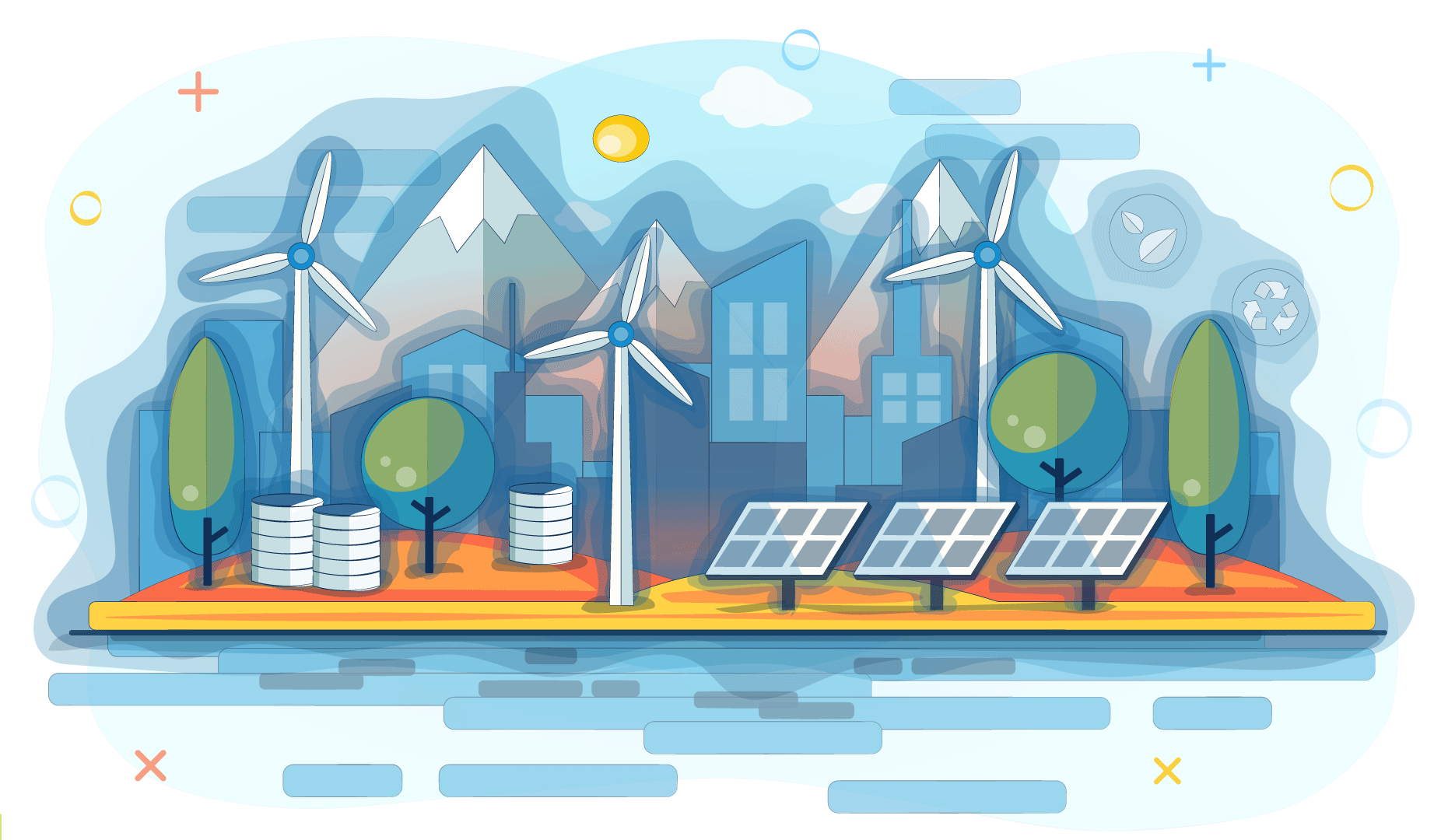Environmental friendliness is both a dominant trend in recent years and a necessary measure in our era of high technologies and mass consumption. At that moment, when scientists loudly started talking about severe environmental pollution and its consequences, everyone began to abruptly switch to "eco". And it's not just about reducing the amount of plastic in products. Saving energy consumption also helps to significantly reduce damage to the ecosystem.
For example, the problem with plastic concerns only manufacturers of goods, but any company can reduce energy consumption. Data centers also contribute to sustainability - data centers that take appropriate actions are called “green”. We will talk further about what these measures are and why the transition to environmental friendliness is important even in this area. But first, let's look at the "theoretical" part of the question.
How do data centers get green?
Any company can self-proclaim their data center environmentally friendly. But this will not make much sense if environmental friendliness is not confirmed by any indicators and certificates. The title of "green" still needs to be obtained - for this there are responsible organizations that check the data center for compliance with energy efficiency requirements. Only after checking, the data center receives a certificate of environmental friendliness.
There are several certification systems now. The most authoritative of them is LEED, and it concerns the environmental friendliness of the data center building itself. The LEED certification system includes assessment according to the following parameters:
- energy efficiency and air emissions;
- water consumption;
- materials and resources used;
- internal environment;
- the location of the data center;
- integration process;
- innovations that were used during the construction.
For each of the points in the evaluation system, the data center receives a certain number of points. Although all the criteria are important, each parameter has its own maximum score. If we consider the verification in this vein, then the main point of the assessment can be called energy efficiency and the amount of emissions into the atmosphere - for it the data center can receive up to 38 points.
The maximum possible result in the LEED certification system is 110 points. But in order for the data center to receive the status of "green", it is enough to pass a certain threshold during the assessment. In addition, the data center is issued a certificate indicating the level of environmental friendliness. It directly depends on the number of points received:
- from 40 - bronze;
- from 50 - silver;
- from 60 - gold;
- from 80 - platinum.
The platinum level in the LEED certification system is the closest to the benchmark. Nevertheless, even the bronze status speaks of environmental friendliness. In 2020, only 31 data centers out of the global total received platinum. 117 data centers received gold certificates.
As already mentioned, the most significant criterion for assessing the environmental friendliness of data centers is energy efficiency. The generally accepted indicator for its assessment is PUE, which has been used since 2007. When checking, the gap between the amount of consumed and used energy is taken into account - the smaller it is, the more environmentally friendly the data center is considered. To calculate, the amount of energy consumed must be divided by the amount of energy used. Thus, you can get a coefficient that will tell you about economical (or not economical) energy consumption. The benchmark is 1. This applies to situations when the amount of consumed and used energy is the same - that is, the data center does not waste it, but uses it optimally.
What measures are taken by green data centers?
Environmental friendliness is a rather capacious concept. The 3R rule will help you get as close to it as possible: reduce, reuse, and recycle. With data centers, things are a little more complicated. In pursuit of environmental friendliness and "green" status, it is also necessary to maintain high efficiency of equipment operation. But there are several measures that are already being actively used in many data centers. Let's consider them in more detail.
Alternative energy sources
The transition to green energy is one of the most important steps that data centers can take in order to be environmentally friendly. The use of own power plants requires a fairly large investment. This also affects the increase in the cost of data center services. Nevertheless, the use of alternative energy sources pays off within a few years after the installation of own power plants by increasing efficiency and reducing subsequent costs.
Wind generators, solar or hydroelectric power plants are most often used as companies' own power plants. It's affordable, tested, and pretty common. The type of power plant is chosen based on the climate. In southern latitudes, the best option would be to use solar installations, near rivers - small private hydroelectric power plants, and on the plains and in areas with strong winds - wind generators.
A more exotic, but also a good type of power plant is geothermal. They are used in data centers in Iceland, and they are especially beneficial in cases where the data center building is located in close proximity to geysers. For example, in Verne Global data centers located near Reykjavik, all energy is obtained from nearby reservoirs or geysers. But, logically, this method of generating electricity is only suitable for certain countries and regions.
Many large corporations have already switched to alternative energy supply. So, Apple installed solar power plants when building new data centers. Own resources are fully sufficient for the power supply of the data center. For example, Apple's data center in Maiden, North Carolina is powered by two solar power plants that generate 84 kWh of energy per year. In addition, the data center also receives energy from fuel systems - about 40 kWh. This is enough for a full and independent power supply.
Cooling naturally
The lion's share of the energy consumed is spent on cooling the server hardware. This raises the aforementioned PUE and is logically against the environmental friendliness of the data center. A study published in the magazine called Energy Procedia indicates that cooling systems alone in a data center make up to 40% of all electricity used, and sometimes more. Accordingly, alternative cooling methods will help reduce costs and increase the efficiency of its use.
For many data centers, the way out of this situation turned out to be more than obvious - this is cooling server equipment by natural means or free cooling. It is most beneficial to use it when the data center is located in northern latitudes or simply in a cold climate. In this case, there is no need to spend resources on the installation and use of special cooling units. It is enough to use cold air outside and install filters through which the airflow will pass. When located in areas with a very low average annual temperature, it is also necessary to provide for slight heating of the air to the optimal temperature.
At the same time, the already exhausted hot air can either be discharged beyond the walls of the data center or partially reused by mixing it with a new cold air stream.
In some regions where the outside temperature is close to zero all year round, only free cooling can be used. In warmer climates, the hybrid method is used, where free cooling mechanisms are also used.
An example is one of the Facebook data centers built in Lulea, Sweden. The sub-arctic climate of this area allowed the PEU to be reduced to an almost ideal 1.07. In addition, the data center is located near the river and is powered by energy from the hydroelectric power plant.
Equipment control, correct disposal, and recycling
Older servers consume more power and are less efficient at the same time. To avoid problems and improve the environmental friendliness of the data center, it is necessary to get new equipment on time. A study on this topic was conducted by Supermicro, and, according to the obtained data, with optimized monitoring of equipment, the performance of the data center increases by about 15%. In combination with a decrease in the PEU indicator, this leads to only positive consequences.
In data centers that want to achieve green status, a lot of attention is paid to the disposal of old equipment. Companies send already unusable equipment and its elements for recycling. Since there can be a lot of such waste, data centers conclude contracts with enterprises that are engaged in the disposal and recycling of waste. In some data centers, literally, everything (from equipment and batteries to paper) is given away for recycling. It may not be energy efficient to get rid of waste paper, but it helps to contribute to the protection of the ecosystem.
Nowadays, all large data centers are doing their best to achieve high environmental friendliness. All of these measures not only help maintain a good reputation for the data center but also directly affect the efficiency of the equipment.

























